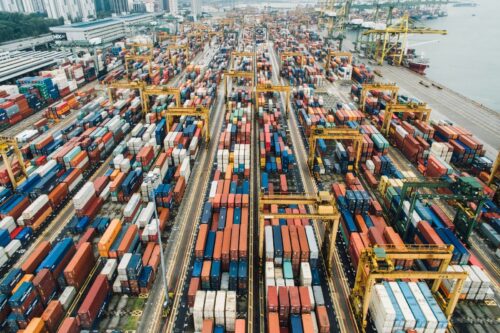Distribution Channels in Logistics: Definition, Types, and Components

Distribution channels in logistics are the lifelines that connect the dots between production and consumption, ensuring that goods find their way to the final customer efficiently and effectively. These channels are not just routes on a map but the strategic networks underpinning efficient supply chain management.
They make sure that inventory management aligns with customer demands and product availability. Their significance cannot be overstated, as they directly influence customer satisfaction and the overall success of supply chain operations.
This guide will equip you with everything you need to understand the complexities of distribution channels. Further, we will discuss the types, benefits, and strategies for overcoming challenges, enhancing your distribution management, and ensuring improved customer satisfaction.
Understanding Distribution Channels
A distribution channel represents the critical networks connecting manufacturers directly to their end consumers. These channels, whether direct or indirect, facilitate the seamless flow of goods, ensuring that products move efficiently from the point of production to the retail outlets and the final consumer.
Their role extends beyond transportation, encompassing inventory management, order fulfillment, and customer satisfaction. By optimizing the distribution process, businesses can achieve an efficient supply chain, reduce transportation costs, and more effectively meet customer demands.
Types of Distribution Channels

Distribution channels in logistics are diverse, offering multiple pathways for products to reach the end consumer.
Here’s a closer look at the primary types:
- Direct Distribution Channels: These channels allow manufacturers to sell directly to the final buyer, eliminating intermediaries. This approach fosters a direct customer relationship, often leading to higher customer satisfaction and customer experience.
- Indirect Distribution Channels: Involving one or more intermediaries, such as wholesalers or retail stores, they can extend the trading range of products and reach a broader target market. They are crucial for businesses that cannot handle distribution independently due to scale, cost, or logistics complexity.
- Hybrid Distribution Channels: Combining elements of direct and indirect methods, hybrid channels offer flexibility in distribution strategy, allowing businesses to tailor their approach to different market segments or product types for optimal market penetration.
Other notable channels include:
- Exclusive Distribution: Selective distribution through a single intermediary, often seen in luxury goods or specialized products, to maintain high control over the distribution process and customer experience.
- Intensive Distribution: Aimed at maximizing product availability, this approach places products in as many outlets as possible, ideal for consumer goods with high demand or low purchase complexity.
- Selective Distribution: A middle ground between exclusive and intensive, selective distribution chooses a limited number of outlets in specific locations to balance market coverage and brand prestige.
Each distribution channel plays a distinct role in the supply chain, tailored to the product’s characteristics, target market, and business goals. Choosing the right distribution channel is crucial for efficient movement of goods, inventory control, and, ultimately, achieving customer satisfaction and business success.
Direct vs. Indirect Distribution Channel
Direct distribution channels and indirect distribution channels serve the same goal: to move products from the manufacturer to the end consumer. The critical difference lies in the path taken.
Direct channels eliminate intermediaries, fostering a closer customer relationship and potentially higher profit margins by selling directly through sales teams, fulfillment centers, or online platforms.
On the other hand, indirect channels involve multiple intermediaries like wholesalers, grocery stores, and retail outlets, expanding the product’s reach but often at the cost of reduced control over the customer experience and slimmer margins.
Both direct and indirect channels play crucial roles in a comprehensive distribution system, chosen based on the product, market demands, and distribution efficiency.
Components of Distribution Channels

Distribution channels are intricate systems composed of several core components, each vital in moving products from production to the end consumer.
Here are the key components:
Manufacturers and Suppliers
At the heart of distribution channels lie the manufacturers and suppliers, the originators of goods. Their role extends beyond mere production; they set the stage for distribution efficiency by determining the product characteristics, inventory levels, and initial distribution strategy.
This foundation is crucial for ensuring that products are ready and available for the next steps in the supply chain.
Warehousing and Storage
Warehousing and storage serve as critical holding points in the distribution process, ensuring that goods are safely stored until they’re ready for order fulfillment. These components manage inventory levels and play a key role in logistics efficiency, allowing for the efficient flow of goods.
By optimizing storage, businesses can minimize costs and improve delivery times, directly impacting customer satisfaction.
Transportation and Logistics
Similarly, transportation and logistics are crucial in distribution channels, connecting warehousing to final mile delivery. Selecting the correct mode—road, rail, air, or sea—based on product needs and efficiency ensures timely delivery.
Effective logistics management coordinates these activities, maintaining an efficient goods flow and high customer satisfaction.
The Role of Technology in Distribution Channels
Technology has revolutionized multiple distribution channels, enhancing efficiency and accuracy at every turn. Here is how the technological advancements have affected the logistical world:
- Artificial Intelligence (AI): By leveraging AI, distribution centers can predict demand accurately, ensuring inventory levels are continually optimized. This foresight helps minimize waste and reduce costs, making the supply chain more sustainable and responsive to market dynamics.
- Automation: The introduction of automation in warehousing has revolutionized the picking and packing process, significantly reducing the time from order to delivery. This efficiency boosts customer satisfaction and allows businesses to handle a higher volume of orders with fewer errors.
- Shipment Tracking: Real-time shipment tracking has elevated the customer experience by offering transparency and peace of mind. Customers and businesses alike can monitor the journey of goods, enhancing trust and reliability in the distribution process.
- Logistical Outsourcing: Partnering with tech-driven logistics providers enables businesses to tap into advanced distribution strategies without the hefty investment in technology. This collaboration ensures that companies can scale their operations flexibly to meet fluctuating customer demands.
- Blockchain Technology: Adding to these advancements, blockchain technology offers unmatched security and transparency in distribution channels. Creating an immutable ledger of transactions ensures the authenticity of products and streamlines supply chain operations, reducing the risk of fraud and errors.
These advancements ensure that products reach customers faster and more reliably than ever, setting new logistics efficiency standards.
Challenges in Managing Distribution Channels
Managing distribution channels effectively is fraught with challenges, from coordination to adapting to market changes. Overcoming these hurdles is vital to maintaining an efficient supply chain.
Let’s explore these challenges and solutions:
Coordination
Coordinating activities across various elements of distribution channels can be daunting. The challenge lies in ensuring seamless operations between manufacturers, sales outlets, and distribution centers to meet end customer demands efficiently. Misalignment can lead to delays, increased costs, and diminished customer satisfaction.
To mitigate these issues, adopting a centralized logistics management system can enhance communication and coordination. Such systems provide real-time data, facilitating better decision-making and ensuring that all parties are synchronized, thus improving the distribution process’s overall efficiency.
Inventory Management
Inventory management is pivotal in balancing raw materials and finished goods to prevent overstocking or stockouts. However, predicting customer demands and adjusting inventory levels can be challenging, affecting the ability to increase sales and maintain an efficient flow of goods.
Leveraging artificial intelligence and analytics for demand forecasting can significantly improve inventory accuracy. These technologies analyze historical sales data and market trends to predict future demands, effectively enabling more precise inventory control and reducing costs.
Integrating Technology Correctly
Integrating technology into distribution channels offers immense benefits but comes with challenges. Ensuring that new technologies align with existing systems and processes without disrupting operations. Additionally, keeping the workforce trained and up-to-date with technological advancements takes time and effort.
A phased approach to technology integration, starting with pilot programs and gradual implementation, can ease the transition. Regular training sessions and workshops can keep the team skilled and confident in using new technologies, ensuring that the distribution process remains smooth and cost-effective.
Adapting to Market Changes
The ability to adapt to rapid market changes presents another challenge. Fluctuations in customer demands, marketing strategies, and the global economy can impact distribution channels significantly. Building a flexible distribution strategy that can quickly respond to these changes is essential.
This might include diversifying distribution channels, investing in scalable logistics activities, and maintaining solid relationships with logistics partners. Such adaptability ensures the distribution system remains resilient and can meet final buyer needs, regardless of market conditions.
Conclusion
Understanding and efficiently managing distribution channels in logistics is paramount for businesses aiming to streamline their supply chain and ensure products reach the end consumer effectively.
These channels, whether direct, indirect, or hybrid, play a significant role in determining the success of direct sales, impacting everything from cost effectiveness to customer satisfaction. Strategic selection and management of these channels are crucial for businesses to thrive in today’s competitive market.
As the distribution landscape continues to evolve, driven by technological advancements and consumer behavior shifts, the need for continuous learning and adaptation becomes more apparent. Staying informed about the latest trends and practices in distribution channels is essential.
